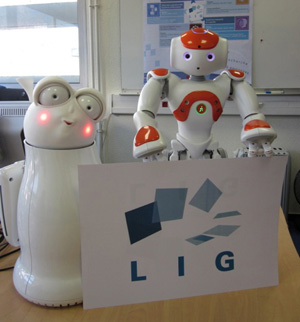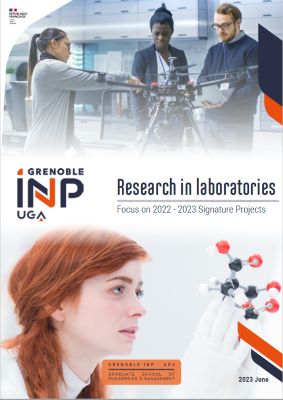It is probable that robots will very soon be integrated aids in our daily life. The MAGMA team at the LIG (Laboratoire d’Informatique de Grenoble – Grenoble information technology laboratory) is working on artificial companions who are smart itnerfactive systems designed to maintain a close, long-term relationship with the user. There are two types of companions: virtual characters and social robots. “More specifically, we are working with commercial robots and we are trying to give them an affectionate aspect in order to offer a real presence in daily life of individuals such as dependent people or the elderly,” explain Sylvie Pesty and Julie Dugdale, researchers at LIG.
 My little world of artificial companions (MoCA - MOn petit monde de Compagnons Artificiels), a project funded by ANR focuses on the study of artificial companions in very specific situations. “For this project, we took a look at the case of children who are alone at home in the evening after school”, explains Sylvie Pesty, who organised the WACAI 2012 conference in Grenoble (Affection, Artificial Companions and Interactions). Of course, the aim is not to replace human presence but to suggest activities or to provide them with advice on the proper behaviour to adopt if something unexpected happens for example.” The problem is finding a way to personalise these companions and to know what to put in this “additional core” required for creating a genuine relationship”.
My little world of artificial companions (MoCA - MOn petit monde de Compagnons Artificiels), a project funded by ANR focuses on the study of artificial companions in very specific situations. “For this project, we took a look at the case of children who are alone at home in the evening after school”, explains Sylvie Pesty, who organised the WACAI 2012 conference in Grenoble (Affection, Artificial Companions and Interactions). Of course, the aim is not to replace human presence but to suggest activities or to provide them with advice on the proper behaviour to adopt if something unexpected happens for example.” The problem is finding a way to personalise these companions and to know what to put in this “additional core” required for creating a genuine relationship”.
Four IT research laboratories with complementary expertise (Lab STICC in Brest, LIMSI in Orsay, LTCI in Paris and LIG in Grenoble) have pooled their efforts on this topic in order to gain greater insight into the concepts surrounding relationship, value, personality and plasticity of the companions. “We are also working with physiologists and ethologists who specialise in human and animal behaviours.” A project to follow closely.
 My little world of artificial companions (MoCA - MOn petit monde de Compagnons Artificiels), a project funded by ANR focuses on the study of artificial companions in very specific situations. “For this project, we took a look at the case of children who are alone at home in the evening after school”, explains Sylvie Pesty, who organised the WACAI 2012 conference in Grenoble (Affection, Artificial Companions and Interactions). Of course, the aim is not to replace human presence but to suggest activities or to provide them with advice on the proper behaviour to adopt if something unexpected happens for example.” The problem is finding a way to personalise these companions and to know what to put in this “additional core” required for creating a genuine relationship”.
My little world of artificial companions (MoCA - MOn petit monde de Compagnons Artificiels), a project funded by ANR focuses on the study of artificial companions in very specific situations. “For this project, we took a look at the case of children who are alone at home in the evening after school”, explains Sylvie Pesty, who organised the WACAI 2012 conference in Grenoble (Affection, Artificial Companions and Interactions). Of course, the aim is not to replace human presence but to suggest activities or to provide them with advice on the proper behaviour to adopt if something unexpected happens for example.” The problem is finding a way to personalise these companions and to know what to put in this “additional core” required for creating a genuine relationship”.Four IT research laboratories with complementary expertise (Lab STICC in Brest, LIMSI in Orsay, LTCI in Paris and LIG in Grenoble) have pooled their efforts on this topic in order to gain greater insight into the concepts surrounding relationship, value, personality and plasticity of the companions. “We are also working with physiologists and ethologists who specialise in human and animal behaviours.” A project to follow closely.





